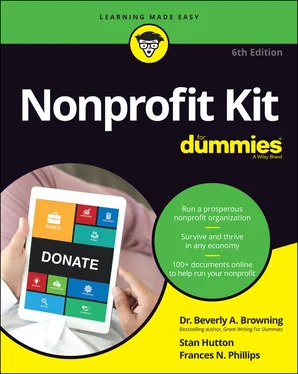Some people are reluctant to serve on boards for other reasons, including personal and financial liability. However, unpaid volunteers who aren’t grossly negligent and who act in good faith have some protection under the Volunteer Protection Act of 1997 and may have additional protections under your state’s volunteer protection laws. If you need more information about the possible liabilities of board members and other volunteers, we suggest that you get in touch with BoardSource ( www.boardsource.org ) or your state’s association of nonprofit organizations through the National Council of Nonprofits ( www.councilofnonprofits.org ).
Organizations can protect their boards by purchasing directors’ and officers’ insurance (see Chapter 22). Generally, the organization’s creditors can’t come after its board members’ personal wealth for payment. An exception is that the IRS can hold board members financially accountable when organizations fail to pay payroll taxes. But even the IRS will work with an organization to develop a payment plan and schedule to catch up on taxes. People are right to take seriously the responsibility of board service, but nonprofit board work also can be fun and satisfying.
Keeping it fresh: Terms of service
Building a board should be a continuing process. Therefore, we highly recommend that your organizational bylaws specify terms of service. Two 3-year terms or three 2-year terms are the most common term lengths for board service. In most cases, bylaws allow reelection to the board after one year’s absence. Limiting terms of service helps you maintain a fresh supply of new ideas, which are more likely to come from people who are new to your organization. Plus, limiting terms of service can help you recruit new board members because your potential recruits know their time commitment is of limited duration.
 To avoid having all your board members leave in the same year, stagger the years when terms expire. You can allow someone to serve an extra year or ask others to serve shorter terms if necessary and if your bylaws allow it.
To avoid having all your board members leave in the same year, stagger the years when terms expire. You can allow someone to serve an extra year or ask others to serve shorter terms if necessary and if your bylaws allow it.
 If you’re thinking about recruiting new board members, create a spreadsheet to help you visualize the skills you need to seek out when you’re looking for new members. Along the top of the grid, list the skills you think you need on your board. Along the side, list your current board members and place check marks under the skills they bring to the board.
If you’re thinking about recruiting new board members, create a spreadsheet to help you visualize the skills you need to seek out when you’re looking for new members. Along the top of the grid, list the skills you think you need on your board. Along the side, list your current board members and place check marks under the skills they bring to the board.
 Check out File 3-2 at
Check out File 3-2 at www.wiley.com/go/nonprofitkitfd6e for a sample grid for planning board recruitment.
Where do you find new board members? Start with your organization’s address book. Whom do you know who may make a good member and be willing to serve? Who benefits from your agency’s work? Who are your agency’s neighbors? Who is actively involved as a volunteer for your agency? Some cities have nonprofit support organizations that can help in this regard. Consider asking your funders for suggestions and look at former board members of other high-functioning nonprofit organizations with similar missions.
 Even if you don’t specify board terms, continuously recruiting new board members is important. As time passes, board members’ lives may change in ways that draw them away from your organization. Many nonprofit organizations lose vitality when their boards don’t refresh themselves with new members.
Even if you don’t specify board terms, continuously recruiting new board members is important. As time passes, board members’ lives may change in ways that draw them away from your organization. Many nonprofit organizations lose vitality when their boards don’t refresh themselves with new members.
Big boards or little boards
Opinions differ about the ideal number of board members. One school of thought holds that big boards are better because the members can divide work among more people, consider more diverse viewpoints, and reach into the community more extensively. Other people say that smaller boards are better because maintaining a working relationship with a smaller group is easier and decision-making is better because the board has to consider fewer opinions. Those who support small boards also say that board members can easily become invisible in a large group, meaning that no one will notice if they fail to do their share of the work.
In our opinion, there is no single correct answer to the board-size question. According to a 2010 BoardSource survey of its members, the average size was 16 members and the median size was 15 members. Nonprofits vary widely in size, function, and type, so what works for one nonprofit may not work for another. Nonprofit board size is truly a case where the phrase one-size-fits-all doesn’t apply.
Consider these points when setting your board’s size:
Start-up nonprofits tend to have smaller boards than more mature organizations. Start-up budgets tend to be smaller, and building a board of directors takes time. State laws generally specify the minimum size required (often, three members).
Boards that are actively engaged in fundraising for major gifts and special events tend to be larger because both fundraising techniques are fueled by personal contacts and friendships. The more board members you have, the more personalized invitations you can send. Some large cultural institutions have 50 board members or more.
Boards that govern nonprofits funded mostly by grants and contracts tend to have fewer members, perhaps an average of 10 to 16 members. Board members in these nonprofits usually have fewer fundraising responsibilities for the organization and frequently are representatives of the communities or clients served. They also may have professional experience in the types of service provided by the nonprofit.
Choosing officers and committees
Typical officer positions of most nonprofit boards include president, vice president, secretary, and treasurer. Sometimes the positions of secretary and treasurer are combined into one office. Your state laws may specify which officers are required. Seniority on the board, professional expertise, and skills in negotiating with and listening to others are common traits sought in a board’s leaders. Ultimately, however, the board of directors chooses the officers. They’re usually elected to 2-year terms. The following list outlines the common responsibilities of board officers:
President (or chairperson): Presides at board meetings, appoints committee chairpersons, works closely with the executive director to guide the organization, and acts as a public spokesperson for the organization (but also may assign this responsibility to the executive director)
Vice-president (or vice-chairperson): Presides at board meetings in the president’s absence and serves as a committee chairperson as appointed by the president
Secretary: Maintains the organization’s records, records minutes at board meetings, and distributes minutes and announcements of upcoming meetings to board members
Treasurer: Oversees the organization’s financial aspects, makes regular financial reports to the board, and sometimes serves as chairperson of the board finance committee
 Check out File 3-3 at
Check out File 3-3 at www.wiley.com/go/nonprofitkitfd6e for more-detailed job descriptions you can use.
Читать дальше

 To avoid having all your board members leave in the same year, stagger the years when terms expire. You can allow someone to serve an extra year or ask others to serve shorter terms if necessary and if your bylaws allow it.
To avoid having all your board members leave in the same year, stagger the years when terms expire. You can allow someone to serve an extra year or ask others to serve shorter terms if necessary and if your bylaws allow it. Even if you don’t specify board terms, continuously recruiting new board members is important. As time passes, board members’ lives may change in ways that draw them away from your organization. Many nonprofit organizations lose vitality when their boards don’t refresh themselves with new members.
Even if you don’t specify board terms, continuously recruiting new board members is important. As time passes, board members’ lives may change in ways that draw them away from your organization. Many nonprofit organizations lose vitality when their boards don’t refresh themselves with new members.










